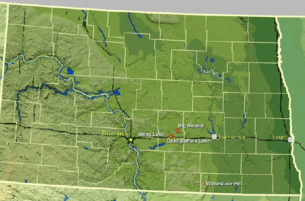Battle of Dead Buffalo Lake facts for kids
Quick facts for kids Battle of Dead Buffalo Lake |
|||||||
|---|---|---|---|---|---|---|---|
| Part of Sioux Wars, American Civil War | |||||||
 Interpretive sign at the battle site |
|||||||
|
|||||||
| Belligerents | |||||||
| United States | Teton and Santee Sioux | ||||||
| Commanders and leaders | |||||||
| Henry Hastings Sibley | Inkpaduta Sitting Bull Gall |
||||||
| Strength | |||||||
| 2,056 | 1,600 | ||||||
| Casualties and losses | |||||||
| 1 dead | 1-15 dead (estimated) | ||||||
The Battle of Dead Buffalo Lake was a skirmish in July 1863 in Dakota Territory between United States army forces and Santee, Yankton, Yanktonai and Teton Sioux. The Sioux attempted to capture the pack train of the army and retired from the field when they were unsuccessful.
Contents
Background
The defeat of Little Crow in the Dakota War of 1862 caused the widespread dispersion of the Santee Sioux or Eastern Dakota. More than 4,000 Santee and other Sioux congregated in the summer of 1863 in a large encampment in present-day Kidder County, North Dakota.
In June and July 1863, Brigadier general Henry Hastings Sibley led a military expedition to punish the Santee. Sibley had 2,056 men – 1,436 infantry, 520 cavalry, and 100 artillery and white and Indian scouts. On July 24, Sibley found the Sioux camp and the Battle of Big Mound ensued. The Sioux retired from the battlefield, the warriors fighting a rear guard action to protect their families for about 12 miles (20 km). As the families continued to flee toward safety across the Missouri River, the warriors paused at Dead Buffalo Lake, about two miles (3 km) northwest of present-day Dawson, North Dakota to await Sibley's advance.
Many of the Santee under their leader Standing Buffalo had been reluctant fighters and appear to have avoided further conflict by fleeing northwest and eventually to Canada, rather than halt at Dead Buffalo Lake. The remaining Santee, Yankton, and Yanktonai whose best known leader was Inkpaduta, were joined by about 650 Hunkpapa and Blackfoot (Lakota) Teton warriors. This brought the number of Indian warriors up to 1,600, according to one estimate. Sitting Bull was among the Teton reinforcements.
Battle
Sibley marched to Dead Buffalo Lake on July 26 and about noon camped near the shores of the small lake. Mounted Sioux appeared shortly on the hills surrounding the lake and Sibley's camp, threatening an attack. Sibley advanced his artillery, two companies of infantry, and his pioneers to a position about 600 yards in advance of his camp and opened fire at long range on the Indians. The Indians withdrew to a safe distance.
The objective of the Sioux seems to have been to capture the army's pack train of horses and mules and immobilize Sibley. They first attempted an assault on Sibley's left flank, but were checked by a company of mounted rangers and two companies of infantry. The Indians then disappeared into the hills. Several muleteers in Sibley's camp assumed the engagement was over and took the livestock out of the defense lines to graze. The Sioux re-appeared in force on the right flank and made another effort to capture the stock, but were repulsed in a brief close-quarter fight by two companies of cavalry and 6 companies of infantry. Sitting Bull, armed with only a whip, was said to have counted coup on a muleteer and captured his mule. Failing in their mission to capture most of the horses and mules, the Indians then retired from the field and the battle was over.
One soldier was killed. The soldiers estimated they had killed 15 Sioux. The number of Indian combatants and Indian casualties were often overestimated by the army.
Aftermath
Sibley continued his pursuit of the Sioux the following day, attempting to catch them before they could cross the Missouri River. On July 28 he engaged them again at the Battle of Stony Lake.
Federal Units Involved
- District of Minnesota: Brigadier General Henry Hastings Sibley
- 1st Minnesota Cavalry "Mounted Rangers": Colonel Samuel McPhail
- 6th Minnesota Infantry: Colonel William Crooks
- 7th Minnesota Infantry: Lieutenant Colonel William R. Marshall
- 10th Minnesota Infantry: Colonel James H. Baker
- 3rd Minnesota Light Artillery Battery: Lieutenant J. C. Whipple


